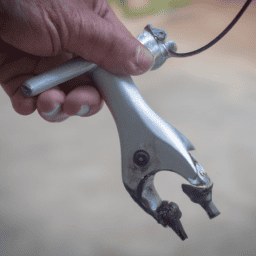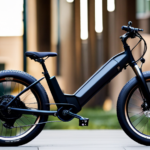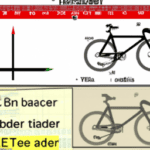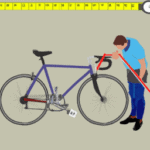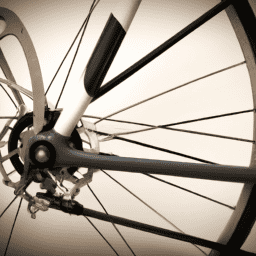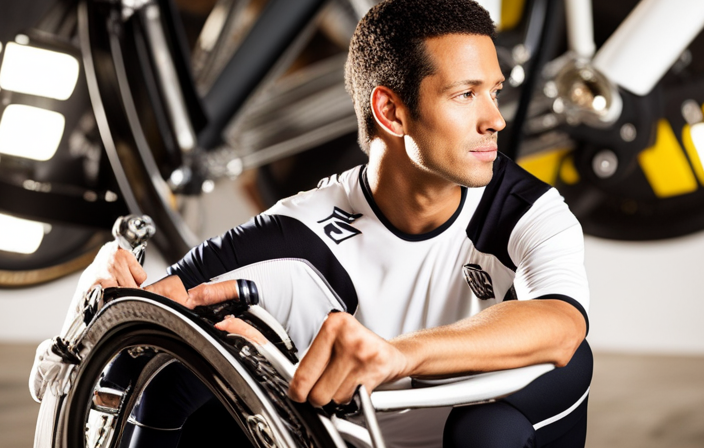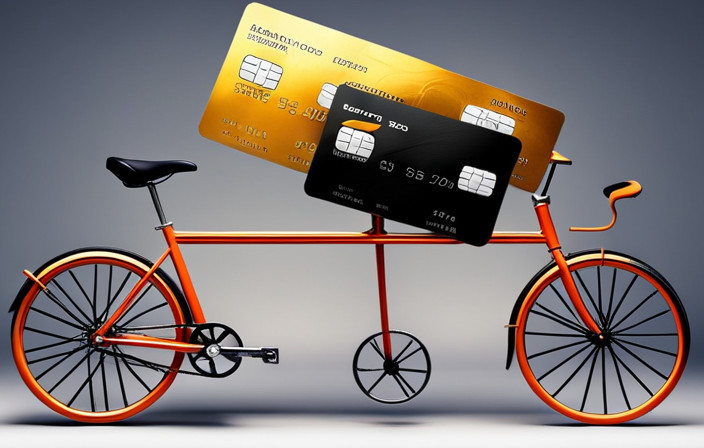When purchasing a bicycle, one crucial aspect to keep in mind is its size. Operating a bike that isn’t the right fit can cause discomfort, pain, and potentially injuries. Therefore, it’s vital to know the appropriate bicycle size for you prior to making a purchase.
To determine the right size, there are several factors to consider, including your height, inseam, and riding style. It’s also important to test ride the bike and make any necessary adjustments. Consulting with experts can also provide valuable insight into finding the perfect fit.
In this article, I will discuss these factors in more detail to help you determine what size bicycle fits you.
Key Takeaways
- Proper bike size is crucial for comfort and performance while riding.
- Height, inseam, and riding style should be considered when determining the right bike size.
- Using a size chart and test riding the bike can help determine the perfect size.
- Proper bike fit should prioritize comfort and safety over aesthetics.
Understand the Importance of Bike Size
You’ll want to make sure the bike you choose fits you properly, as having the right size can make all the difference in your comfort and performance while riding.
One of the most common mistakes people make when purchasing a bicycle is choosing a size that is either too big or too small for them. This can lead to discomfort, poor posture, and even injury.
On the other hand, when you have a bike that fits you well, there are numerous benefits. You’ll feel more comfortable, have better control over the bike, and be able to ride for longer distances without feeling fatigued. Proper bike fit can also lead to increased efficiency and power, as well as reduced risk of injury.
So, it’s important to take the time to determine the right size for you before making a purchase.
Now, let’s move on to the next step of determining your height and inseam.
Determine Your Height and Inseam
To determine the right bike size for me, I need to measure my height and inseam. I can easily do this with a measuring tape and a friend’s help.
Once I have my measurements, I can use a size chart to find the perfect fit for my body type.
How to Measure
Measuring your body is key to finding the perfect size bike for you, so grab a tape measure and get ready to take some measurements!
When it comes to measuring techniques, there are a few things to keep in mind to ensure accuracy. First, make sure you’re standing up straight with your feet flat on the ground and your back against a wall. This’ll help you maintain a consistent posture throughout the measurement process.
Second, measure your height without shoes on. Stand with your back against the wall and use the tape measure to measure from the floor to the top of your head. Next, measure your inseam by standing with your back against the wall and placing a book or other flat object between your legs, up against your pelvis. Measure from the top of the book to the floor.
Finally, avoid common mistakes such as rounding up or down on measurements, which can lead to a bike that’s either too big or too small.
Using a size chart can help you determine the right size bike based on your measurements. However, it’s important to keep in mind that different brands and models may vary in size, so it’s always a good idea to test ride the bike before making a final decision.
Using a Size Chart
Once you’ve got the right measurements, it’s crucial to find a size chart that’ll help you confidently choose the perfect bike for your needs.
Choosing brands that offer a variety of sizes is important, as each brand may have slightly different measurements for their bikes. It’s important to compare sizes across different brands to ensure you’re getting the right fit.
Most bike manufacturers provide size charts that’re specific to their brand, which can easily be found on their website or in-store. These charts typically take into account your height, inseam, and riding style to recommend the appropriate size for your body. It’s important to note that these charts are just a starting point, and it’s always recommended to test ride a bike before making a purchase.
When considering your riding style, you may find that a size chart recommends a slightly different size than what you initially thought. This is because different riding styles require different bike geometries, and a size that may be appropriate for leisurely rides may not be suitable for more aggressive or competitive riding.
Keep this in mind when choosing a bike size, and always prioritize comfort and safety over aesthetics.
Consider Your Riding Style
When considering my riding style, I need to determine what type of bike will best suit my needs. Road bikes are designed for speed and efficiency on pavement, while mountain bikes are built for off-road terrain. Hybrid bikes offer a mix of both styles, with a more comfortable riding position and the ability to handle a variety of surfaces. Other styles, such as touring bikes or recumbent bikes, may also be worth considering depending on my specific needs.
Road Bikes
If you’re looking for a fast and efficient ride, a road bike might be the way to go – as the saying goes, "smooth roads never make good cyclists."However, it’s important to ensure that your road bike fits you properly and has the right geometry. Road bike fit is crucial for both comfort and performance. The wrong fit can lead to discomfort and even injury, while the right fit will allow you to ride faster and longer.
When it comes to road bike geometry, there are three key measurements to consider: the stack, reach, and standover height. The stack is the vertical distance from the center of the bottom bracket to the top of the head tube. The reach is the horizontal distance from the center of the bottom bracket to the top of the head tube. Finally, the standover height is the distance from the ground to the top of the top tube when the bike is standing upright. By considering these measurements and matching them to your body, you can ensure that your road bike fits you properly and provides the best possible ride.
Transitioning into the subsequent section about mountain bikes, it’s important to note that while road bikes are designed for speed and efficiency on smooth roads, mountain bikes are designed for off-road terrain and rougher conditions.
Mountain Bikes
Get ready to tackle any terrain with the ultimate off-road machine – the mountain bike! Mountain bikes are designed to handle rough and rocky trails, with their sturdy frame, wide tires, and suspension system.
The suspension is a crucial component of a mountain bike as it helps absorb shocks and bumps while riding on uneven surfaces. There are two types of mountain bike suspensions – front suspension and full suspension. Front suspension is located on the front fork and is ideal for riders who plan to ride on moderate trails. Full suspension, on the other hand, has both front and rear suspension, making it perfect for more technical and challenging trails.
Choosing the right tires for your mountain bike is also crucial as it can greatly impact your riding experience. The two main types of mountain bike tires are slick tires and knobby tires. Slick tires are ideal for smooth and hard-packed surfaces, while knobby tires are perfect for loose and rocky trails. Additionally, you should also consider the tire width, as wider tires provide more stability and traction.
With the right suspension and tires, a mountain bike can take you on an adventure through any terrain.
Now, let’s move on to the next topic of hybrid bikes.
Hybrid Bikes
Ready for a ride that combines the best of both worlds? Hybrid bikes offer the perfect blend of road and mountain biking, making them versatile and adaptable to any terrain. When choosing a hybrid bike, it’s important to consider the features that suit your needs.
Here are four key features to look for:
-
Frame: Choose a frame that is comfortable and suits your riding style. Hybrid bikes typically have a more upright riding position than road bikes, making them easier on the back and neck.
-
Tires: Look for tires that are wider than those on a road bike, but narrower than those on a mountain bike. This will give you the perfect balance of speed and stability.
-
Gearing: Choose a bike with a wide range of gears to tackle any terrain. Hybrid bikes typically have a wider range of gears than road bikes, but not as many as mountain bikes.
-
Brakes: Look for reliable, responsive brakes that can handle any weather conditions. Hybrid bikes typically have either rim brakes or disc brakes, with disc brakes providing better stopping power in wet conditions.
When it comes to choosing the right hybrid bike brand, there are many great options out there. Some popular brands include Trek, Giant, Cannondale, and Specialized. Consider trying out bikes from different brands to find the one that suits your needs and preferences best.
As we move on to other styles of bikes, it’s important to remember that each type of bike has its own unique features and benefits.
Other Styles
Exploring other styles of bikes can open up a whole new world of excitement and adventure, allowing you to find the perfect ride to match your unique personality and preferences.
Single speed bikes, for example, are simple and lightweight, making them perfect for city riding or commuting. They have a fixed gear, which means the pedals move in tandem with the rear wheel, giving riders a more efficient and responsive ride.
Cruiser bikes, on the other hand, are designed for comfort and style, with wide seats, swept-back handlebars, and balloon tires. They are perfect for leisurely rides along the beach or through the park.
If you’re looking for something even more versatile, folding bikes might be the perfect fit. These compact bikes are perfect for people who need to store their bike in a small space or take it on public transportation. They are also great for travelers who want to explore new places on two wheels.
Electric bikes are another option, offering an extra boost of power for longer rides or uphill climbs. They are perfect for commuters or people who want to cover more ground without getting too tired.
With so many options available, it’s important to test ride and adjust your bike to make sure it fits you properly. The right size bike will make all the difference in your comfort and enjoyment on the road.
Test Ride and Adjust
Once you’ve identified a bicycle that you think might fit you, hop on for a test ride and make any necessary adjustments to the seat and handlebars.
It’s important to maintain proper posture while riding, so adjusting the seat height is crucial. Your knees should be slightly bent when the pedals are at their lowest point, and your feet should be flat on the ground when you come to a stop. This will help prevent injury and ensure a comfortable ride.
Additionally, adjusting the handlebar position can help you find a comfortable grip and reduce strain on your neck and shoulders.
To make the necessary adjustments, follow these steps:
- Loosen the bolts on the seat or handlebars using an appropriate tool.
- Adjust the height or position accordingly.
- Tighten the bolts back up, making sure everything is secure.
- Take a short test ride to see how the adjustments feel.
Once you’ve made these adjustments and taken a test ride, you may find that the bicycle fits you perfectly. However, if you’re still not quite comfortable or have any other concerns, it’s always a good idea to consult with experts before making any further changes.
Consult with Experts
Don’t hesitate to seek advice from professionals to ensure you’re making the most informed decision about your new ride. Consulting with experts can help you determine the appropriate size and fit for your body type and riding style.
One option is to utilize online consultations with certified bike fitters. These consultations allow you to communicate with experts remotely, providing measurements and discussing your preferences to receive personalized recommendations.
Another option is to seek out local bike fitting services. Many bike shops offer this service and have experienced staff who can help you find the perfect fit. They may use tools like motion capture technology and pressure mapping to analyze your body position and make adjustments to ensure maximum comfort and efficiency.
These services may come at a cost, but investing in a proper bike fit can prevent discomfort and injury in the long run. Ultimately, consulting with experts can help you find the right size and fit for your bicycle, leading to a more enjoyable and comfortable ride.
Frequently Asked Questions
How do I choose the right type of bike for my needs?
I understand the importance of choosing the right bike for my needs. Factors to consider include terrain, riding style, and budget. Proper bike fit is crucial for comfort and performance. Let’s explore the options together.
Can I adjust the handlebars and seat to fit my body better?
Yes, adjusting the handlebars and seat can improve your posture and ensure proper alignment. Experiment with different heights and angles until you find the most comfortable and efficient position for your body.
What are some common mistakes people make when choosing a bike size?
One common mistake when choosing a bike size is relying solely on height as a measurement, ignoring other factors like inseam length and riding style. Accurate measuring techniques are necessary to avoid discomfort and injury.
How often should I get my bike professionally fitted?
Getting a professional bike fitting is recommended every 1-2 years or when experiencing discomfort or changes in fitness level. Self-fitting can provide benefits, but signs you may need professional fitting include pain, numbness, or difficulty reaching handlebars or pedals.
Are there any specific brands or models of bikes that are better for certain body types or riding styles?
I’ve found that certain brands and models are better suited for different body types and riding styles. Comfort vs performance is a trade-off to consider, as is road vs mountain. It’s important to research and test ride before making a purchase.
Conclusion
In conclusion, finding the right size bike is crucial to a comfortable and safe riding experience. It’s important to measure your height and inseam accurately, as well as consider your riding style, to ensure a proper fit. Testing out different bikes and making adjustments can also help ensure a comfortable ride.
But what about those who may be in between sizes or have an unusual body shape? It’s true that finding the perfect fit may be a challenge, but it’s not impossible. Don’t be discouraged if it takes some time to find the right bike – remember that a little extra effort now can save you a lot of discomfort and potential injury in the future.
With patience and the help of experts, you can find a bike that fits you like a glove and allows you to enjoy the thrill of cycling to the fullest.

